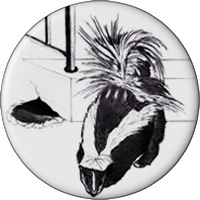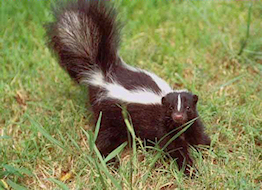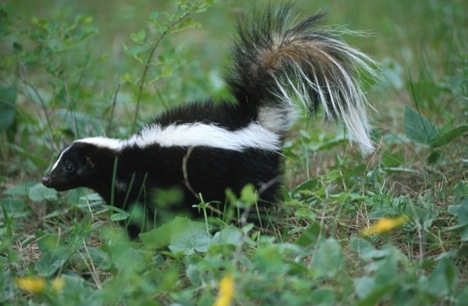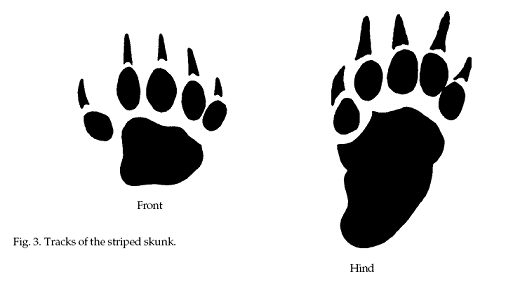SkunksIdentification
General Biology, Reproduction, and Behaviour
The normal home range of the skunk is 2 to 5 km (l/2 to 2 miles) in diameter. During the breeding season, a male may travel 6.4 to 8 km (4 to 5 miles) each night.Skunks are dormant for about a month during the coldest part of winter. They may den together in winter for warmth, but generally are not sociable. They are nocturnal in habit, rather slow-moving and deliberate, and have great confidence in defending themselves against other animals. Food Habits Skunks eat plant and animal foods in about equal amounts during fall and winter. They eat considerably more animal matter during spring and summer when insects, their preferred food, are more available. Grasshoppers, beetles, and crickets are the adult insects most often taken. Field and house mice are regular and important items in the skunk diet, particularly in winter. Prairie hares, cottontail rabbits, and other small mammals are taken when other food is scarce. Damage and Damage Identification Skunks become a nuisance when their burrowing and feeding habits conflict with humans. They may burrow under porches or buildings by entering foundation openings. Garbage or refuse left outdoors may be disturbed by skunks. Skunks may damage beehives by attempting to feed on bees. Occasionally, they feed on corn, eating only the lower ears. If the cornstalk is knocked over, however, raccoons are more likely the cause of damage. Damage to the upper ears of corn is indicative of birds, deer, or squirrels. Skunks dig holes in lawns, golf courses, and gardens to search for insect grubs found in the soil. Digging normally appears as small, 7 - 10cm (3 - 4 inches) cone-shaped holes or patches of upturned earth. Several other animals, including domestic dogs, also dig in lawns. Skunks occasionally kill poultry and eat eggs. They normally do not climb fences to get to poultry. If skunks gain access, they will normally feed on the eggs and occasionally kill one or two fowl. Eggs usually are opened on one end with the edges crushed inward. Weasels, mink, dogs and raccoons usually kill several chickens or ducks at a time. Dogs will often severely mutilate poultry. Tracks may be used to identify the animal causing damage.
Odour is not always a reliable indicator of the presence or absence of skunks. Sometimes dogs, cats, or other animals that have been sprayed by skunks move under houses and make owners mistakenly think skunks are present. |



 The skunk, a member of the weasel family, is represented by four species in North America. The skunk has short, stocky legs and proportionately large feet equipped with well-developed claws that enable it to be very adept at digging. The striped skunk is characterized by prominent, lateral white stripes that run down its back. Its fur is otherwise jet black. Striped skunks are the most abundant of the four species and the one common to Alberta. The body of the striped skunk is about the size of an ordinary house cat (up to 74 cm [29 inches] long and weighing about 3.6 kg [8 pounds] ). The spotted skunk is smaller (up to 54 cm [21 inches] long and weighing about 1kg [2.2 pounds]), more weasel like, and is readily distinguishable by white spots and short, broken white stripes in a dense jet-black coat.
The skunk, a member of the weasel family, is represented by four species in North America. The skunk has short, stocky legs and proportionately large feet equipped with well-developed claws that enable it to be very adept at digging. The striped skunk is characterized by prominent, lateral white stripes that run down its back. Its fur is otherwise jet black. Striped skunks are the most abundant of the four species and the one common to Alberta. The body of the striped skunk is about the size of an ordinary house cat (up to 74 cm [29 inches] long and weighing about 3.6 kg [8 pounds] ). The spotted skunk is smaller (up to 54 cm [21 inches] long and weighing about 1kg [2.2 pounds]), more weasel like, and is readily distinguishable by white spots and short, broken white stripes in a dense jet-black coat. Adult skunks begin breeding in late February. Yearling females (born in the preceding year) mate in late March. Gestation usually lasts 7 to 10 weeks. Older females bear young during the first part of May, while yearling females bear young in early June. There is usually only 1 litter annually. Litters commonly consist of 4 to 6 young, but may have from 2 to 16. Younger or smaller females have smaller litters than older or larger females. The young stay with the female until fall. Both sexes mature by the following spring. The age potential for a skunk is about 10 years, but few live beyond 3 years in the wild.
Adult skunks begin breeding in late February. Yearling females (born in the preceding year) mate in late March. Gestation usually lasts 7 to 10 weeks. Older females bear young during the first part of May, while yearling females bear young in early June. There is usually only 1 litter annually. Litters commonly consist of 4 to 6 young, but may have from 2 to 16. Younger or smaller females have smaller litters than older or larger females. The young stay with the female until fall. Both sexes mature by the following spring. The age potential for a skunk is about 10 years, but few live beyond 3 years in the wild. Both the hind and forefeet of skunks have five toes. In some cases, the fifth toe may not be obvious. Claw marks are usually visible, but the heels of the forefeet normally are not. The hind feet tracks are approximately 6.3 cm (2 1/2 inches long) (Fig. 3).
Both the hind and forefeet of skunks have five toes. In some cases, the fifth toe may not be obvious. Claw marks are usually visible, but the heels of the forefeet normally are not. The hind feet tracks are approximately 6.3 cm (2 1/2 inches long) (Fig. 3).